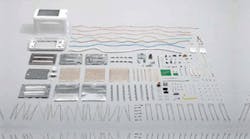When Thomas Thwaites was a second-year postgraduate design student at the Royal College of Art in London, he decided to build a toaster for his master's degree project. This was no ordinary quest involving trips to the hardware store. Instead, he embarked on a nine-month, 2,000-mile journey and spent $1,800 to build the appliance from scratch — literally from the ground up. Why? He wanted to discover where the “stuff” of our lives comes. He first dissected a $6 toaster into 157 parts and then attempted to create a working replica.
Thwaites shares some insights from his descent into the heart of reverse engineering.
What inspired you to build a toaster from scratch?
I wanted to try and connect the objects that surround me with the ground from whence they came. I know intellectually that plastics and metals are mostly derived from fossil fuels and rocky ores, but that knowledge doesn't quite fit my experience. How does all the stuff in a highly specialized machine like a photocopier, or a toaster, come from dirt? It can only happen after an unfathomably complex transformation over thousands of years. But just because something is unfathomable doesn't stop one wanting to fathom it, and hence, the Toaster Project.
What was your toughest challenge?
I wanted to make a spring to pop up the toast, so I needed steel. I assumed steelmaking wouldn't be too hard, given the fact that it's ubiquitous in our civilization. Although steel was made several hundred years ago in certain places, and vast quantities are now produced industrially, making a small amount at home is extremely difficult. With my first attempt, I think I refined the ore to some degree, but the black, hard, metallic-tasting lump wasn't workable into toaster shapes. I assumed it'd be easy to smelt iron because “we” have been doing it for thousands of years. But I realized we're not innately smarter than our ancestors. In the end, I used a microwave to do the smelting by experimenting with different times, crucibles, charcoal mixtures, and partially refined or raw ore. I got workable iron in the end, but it was a long and dirty — and fun — process.
What's the main lesson you learned?
We're all connected to each other, and to vast numbers of people now dead, through the economy of things.
What's next for you?
I'm supposed to be doing a project about the “home of the future,” exploring some of the questions posed by the Toaster Project. This has been delayed due to filming a new TV series, in which I attempt to make other common household items from scratch.
The Toaster Project by Thomas Thwaites is available from amazon.com and other booksellers.



